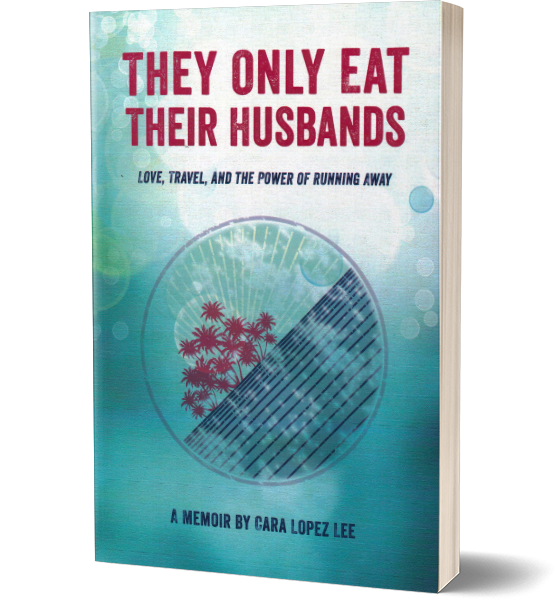As we close in on the steaming mountain that killed some 80 people in 1968, I ask the driver, “The hotel is not this close to the volcano is it?”
“No.”
Whew.
“The hotel is closer,” he says.
The ominous Volcán Arenal looms ahead. Costa Rica’s most active volcano is just three miles away.
When school kids make volcanoes for science class, their models look like this one – a perfect cone covered in gray ash, belching smoke from its crater. Throw a green cape across one shoulder, and you have Arenal. My heart pounds with excitement as I turn to my fiancé, Dale, grinning. Still…
“Is it safe?”
The driver shrugs.
Well, it is sort of stupid to ask now. Our wedding is in two days, and we’ve already selected Arenal as our altar.

We’ve already selected Volcán Arenal as our wedding altar.
When we arrive at the Hotel Arenal Paraíso, the 5300-foot cone fills the sky. Our cabin has a front row seat to one of nature’s hottest shows. Clouds veil the crater, and sunset suffuses them with a rosy glow. At day’s end, the clouds thicken and drop, until only the base is exposed.

Our cabin has a front row seat to one of nature’s hottest shows.
At nightfall, a sudden boom makes us both jump, giggling at Volcán Arenal’s powerful greeting. I lie awake listening to the moaning sighs of the volcano crying over his secret sorrows. I wonder how local Ticos (Costa Ricans) can sleep through the ruckus.
The next day, we explore the jungle, starting with La Catarata de La Fortuna, an intimidating 230-foot waterfall. We hike 500 steps down a steep slope to reach the bottom. The catarata is a roar of white, creating a suction so strong it could kill anyone foolhardy enough to swim directly underneath. Instead, we turn to the calm, clear, green pool nearby, to swim with a handful of locals and tourists, for the 15 minutes that we can stand the heart-stopping chill.

The 230-foot Catarata de La Fortuna creates a suction so strong it could kill anyone foolhardy enough to swim directly underneath.
Our next stop is Las Puentes Colgantes del Arenal, “The Hanging Bridges of Arenal.” Trails linking more than a half-dozen bridges take us into the canopy of the rainforest. The tallest bridge is more than 100 feet high, the better to see the outlandishly oversized trees and plants.
More than 1400 tree species make their home in Costa Rica. This jungle is so alive we can almost hear it breathing. Its plants produce 100 tons of oxygen per two and a half acres each year. Some plants also walk: the Walking Palm crawls across the forest floor until it finds a place to reach upward to the sun. Below the trees, shocking pink begonias and orange-sherbet lantanas look almost microscopic. Lower still, leaf-cutter ants scurry to and fro, looking like tiny windsurfers with green sails.
“How do they cut the leaves?” I ask.
“With very tiny scissors,” Dale quips.
He’s right: the leaf-cutters do use scissors, in their jaws, to cut the leaves. They take the leaves to their nest, where they chew them up and spit them out. The regurgitated plants grow a fungus, which the ants’ eat.
Little do these tiny pukers know their precarious hold on life. Most of Costa Rica’s rainforests have been destroyed to make way for banana trees, coffee plants, and cattle. This country was once three-quarters tropical forest – now it’s less than a quarter.
As if in protest, Arenal roars.
After five centuries of silence, the volcano exploded into life in 1968, due to a build-up of pressure beneath a plug of material inside the cone. The eruption sent fiery rocks, ash, and poisonous gases flying, killing about 80 people and 45,000 head of cattle, and obliterating two villages. But people still live nearby. Our guide, Juan Carlos, explains, “It is safe now because the crater is open.”

The volcano killed some 80 villagers in 1968, but people still live nearby.
Safe is relative. In 2000, another eruption killed an American woman and a guide. They were touring the volcano’s north slope, when hot rock, ash, and gas flew toward them at 80 miles an hour, burning them severely. After that, local tourism businesses took one giant step back.
On our wedding day, we put volcano safety to the test, driving to Arenal National Park to view the eruptions on its active western slope. We stand a few feet from the warning sign that marks the outer limit of the “Danger Zone.” The volcano’s sounds are a cross between the heavy breathing of an obscene phone caller, and a train chugging into a station. Arenal doesn’t display graceful lava flows, preferring the rock-throwing tantrums of a bully. Every few minutes, the giant tosses smoking boulders down the slope. He seems hungry for a sacrifice.

Every few minutes, the giant tosses smoking boulders down the slope.
Back at the hotel, we make the most frightening sacrifice we can imagine: marriage. Because we’re foreigners, an attorney conducts our ceremony. My girlfriend and her husband are our only witnesses. Dale and I wed at sunset, with the rose-gold volcano filling the sky behind us. A halo of clouds drifts over the crater. Arenal falls silent, holding his breath to hear our vows.
We, too, listen carefully, because the attorney’s English is heavily accented. When he says, “This is my wife, whom I sherish above all otters,” my groom doesn’t repeat after him – just blurts out, “What?!”
Dale politely ignores suggestions that he throw his bride into the crater as a finale. We simply walk to the lodge for dinner and a natural fireworks show. As the sky darkens, a shower of red-hot rocks blazes a fiery trail down the mountainside. It’s the first time we’ve seen the red glow, invisible by daylight.

Dale politely ignores suggestions that he throw his bride into the crater as a finale.
On my wedding night, I wake in the wee hours to watch The Late Show. The volcano is a shadow, highlighted by violent cataratas of red. In counterpoint, two shooting stars arc across the sky in a burst of white heat. A howler monkey roars in the dark, sounding like a lion with a cold.

On my wedding night, I wake in the wee hours to watch The Late Show.
“Dale!” I hiss.
“I heard it,” he whispers back.
The volcano beats his angry drums deep into the night. It seems our wedding didn’t soothe the savage beast. Perhaps this 39-year-old blushing bride was not the virgin sacrifice he had in mind.




